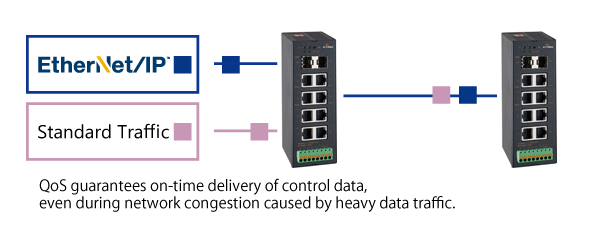Explore network intelligence with QoS.
QoS Concept Made Simple
Quality of Service (QoS) in networking includes technologies for enhancing the performance and reliability of network services and applications. It ensures different types of network traffic receive the appropriate priority and guarantees a seamless user experience.
This mechanism prioritizes network traffic and manages available bandwidth according to specific set requirements. It strives to maintain reliable data transfers, enhancing network quality through efficient capacity allocation and data flow management. When effectively implemented, QoS equips admins to streamline network control, optimize performance, and deliver consistent user experience.
Why Should You Use QoS
QoS makes sure important data gets to its destination first, especially when the network is busy, a feature commonly found in managed switches and certain control devices like PLCs. However, managed switches often come at a higher cost. Now, you have the option to go for more budget-friendly unmanaged switches with QoS capabilities. This way, your critical data arrives as you expected, offering a cost-effective alternative.
Implement QoS to address bandwidth congestion, prioritize network traffic (e.g., favoring one VLAN), and mitigate intermittent issues. In ITS systems, QoS manages surges in CCTV data, ensuring critical data isn't compromised. Additionally, QoS resolves interference problems like packet loss, jitter, and latency.
QoS Redefines Your Network Traffic
- Bandwidth Management: Directs router bandwidth allocation, assigning specific bandwidth to various traffic types. This optimizes link speed and ensures efficient network performance by prioritizing critical traffic.
- Latency Control: Creates priority queues for specific traffic types, minimizing queuing delays during congestion. This results in faster packet transmission from source to destination, ensuring smoother and more responsive network performance.
- Jitter Reduction: Manages congestion-related speed variations, ensuring timely and orderly packet delivery. This prevents audio and video distortion or gaps, resulting in a smoother and more reliable media experience.
- Packet Loss Mitigation: Allows admins to decide which packets to drop in cases of network congestion, reducing data loss. This results in improved network reliability and a smoother data transmission experience.

Join the Fast Lane Advantages

Elevates Experience
Discerns traffic patterns and allocates priorities, ensuring seamless communication for critical applications with quick response times.

Heightens Security
Empowering admins to set QoS security policies enables them to block unwanted traffic, reinforcing application security.

Optimizes Resource
Refines bandwidth allocation, preventing resource monopolization and ensuring efficient resource utilization.

Saves on Costs
Efficient resource management through QoS translates to reduced network operational expenses.

Fortifies Reliability
Smart packet queuing by QoS averts traffic jams, minimizing data packet loss and elevating overall network reliability.
MAX Your Network Performance
In the world of network management, you've got the power to make complex networks run smoothly. It's all about prioritizing critical applications by reserving bandwidth to ensure uninterrupted access, even during peak hours.
Use queuing systems and adaptable QoS settings to handle changes effortlessly and keep the traffic flowing. Optimizing vital applications and setting up your network devices to enforce QoS policies will supercharge your network performance. The result? A rock-solid minimized congestion and ensured seamless user experiences for real-time applications like video surveillance, VoIP, and SCADA systems, enhancing overall network performance and reliability of entire network environments.









